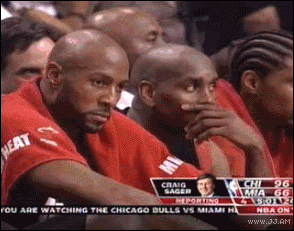SSOL wrote:Ghost of Kleine wrote:SSOL wrote:This is a fallacy and one that has been disproven time and time again. You really think that these big brand shoe companies would pour all that money into an endorsement knowing full well that their star athlete is more likely to go down in that product?
Here is a good article on the topic with a study included:
https://advance.muschealth.org/library/2020/september/high-tops-or-low-tops
Your opinion being noted man. Yet regardless of your suggestion that this is a fallacy ( which it obviously isn't if you only look at the increasing frequency of ankle injuries since trending to low top sneakers), We're still seeing a large increase of frequent ankle injuries that mysteriously didn't seem to occur with the same level of prevalence back when players primarily wore high tops. So if this is truly a fallacy as you're implying, what would you target as the determining factor to this increase currently? Maybe that all of this generations athletes just physiology have weaker ankle dexterity? That these elite training staffs these teams apparently have are just forgetting how to tape the players up AS EFFECTIVELY as what they previously have done? That they're aware of these stability concerns, but just can't find the time to implement the proper strength and conditioning programs to increase supportive stability?
And whether it might surprise you or not, these ( big shoe companies) producing these shoes mass scale production, are usually focused more on fashion trends and aesthetics as they're predominantly selling these shoes to the general public as their target beyond the shoe endorsements. Their main client base beyond the singular shoe models for the endowment athlete is again targeting the general public and not high end athletes. As such, they're often more focused on mass production and the above mentioned fashion/ aesthetics criteria than the overall individual quality of the shoes above based standards.
Just reflect on the customary processes that they use to build the sneakers and who they predominantly use towards that goal. It's not like they high end structural engineers or shoe experts perfecting each shoe on an assembly line man. They use low scale methods to cut cost whilst promoting large scale production. And regardless of your posted article, it's only common sense that if you have ankle stability issues and/ or weak ankles, that having support for that in the form of taping, braces, sleeves, or shoes with higher ankle support as opposed to just none ( in low tops), providing that additional support is simply better than not having it when/ if ankle stability issues are prevalent.
I am not stating an opinion, it is fact. I provided you with an article and a study and I can find more if you would like. But please feel free to provide data that shows an increase in the type of injury you are referencing and how it correlates to a change in sneaker design. I work in the sports industry and when I see blatant eye test opinions when actual data and facts suggest otherwise, I’m going to speak on it.
Of course I can respect that you'll respond to things you disagree with. And yes you did provide for an article with a study done, and thank you for that. And yes I do understand that you also work with the suns in some capacity as well and it's not at all that I don't respect you or your opinions or what you're stating as fact in most premises either. But there are other articles out there as well that have furnished similiar studies and found differing, mixed or inconclusive results as to the outcome of your position. In kind, allow me to share some:
First to your request for data/ studies on shoe design correlation to potential ankle injuries or instability issues being a legitimate factor-
https://www.bsmpg.com/articles---resources-0/bid/71470/Basketball-Sneakers-Ankle-Sprains-and-Ankle-PainsPosted by Boston Sports Medicine and Performance Group on Aug 14, 2011 9:20:00 AMSo what do “fancy” shoes have that ordinary shoes do not?
The answer may be found in a 2001 study by McKay. Although McKay’s group did not set out to determine the manufacturing differences between lower end and high end shoes, their findings did point to one feature within many athletic shoes that may very well be to blame. In this study researchers sat courtside and watched over 10,000 recreational basketball participants as they played to determine the rate of ankle injury and examine risk factors of ankle injuries in recreational basketball players. Each participant completed a questionnaire which included questions related to: age, sex, height, weight, protective equipment (ankle brace, mouth guard, etc), shoe type (cut low, med, high), age of shoes, whether the participant performed a warm-up prior to playing, and of course questions identifying their injury history.
After analyzing the data, three risk factors emerged:
1. Previous ankle sprain – those athletes with a previous sprain were almost 5 times more likely to sprain again.
2. Players who did not stretch prior to games were 2.6 times more likely to injure their ankles then those that did.
3. Players wearing air cells in the heels were 4.3 times more likely to injure an ankle compared to those with no air cells in their heels. (It may be hypothesized that air cells located in the heels of basketball shoes decrease rear foot stability, which may in turn increase the risk of ankle injury.)
“So let me get this straight; shoes with air cells, which were placed within the shoe to help the athlete absorb shock or jump higher actually increased their risk of injury?”
STOP BUYING SHOES WITH AIR FILLED CELLS! There is really two pieces in play here. One - the fact that you’re much higher off the ground inherently makes “tipping over” much easier (ever walk behind a girl wearing stilettos on a Saturday night and witness her ankle flop about? Makes me cringe just thinking about it) and two – add an unstable surface(a pocket full of air – may as well just duck tape a dynadisc to the bottom of your shoe) to those stilettos and you have the perfect design for the inversion ankle sprain.
At it's basest form, this article still actually does indicate that shoe design can affect/ contribute to potential ( inversion) ankle injuries.
https://www.sportsinjurybulletin.com/diagnose--treat/prevent/injury-prevention-shoe-facts-shoe-fictionThe information laced throughout this article is excessive for this post, but upon reading you'll find that it also validates the elements of shoe design in structural support premises towards injury minimization/ prevention. I'm only adding this brief inclusion for the prevalence of structural support ( design) towards mitigating or minimizing ankle inversion/ torsional flexion, etc as a means of supportive proprioceptive management.
Another commonly overlooked but essential factor is the shoe closure mechanism. A Belgium study found that runners seeking to avoid an injury should select shoes that fit well with a suitable closure mechanism, which ensures a comfortable and snug fit(9). This factor was deemed MORE critical for injury prevention than selecting a running shoe from a gait analysis or by relying on recommendations from shoe store staff!
So again, this study indicates that shoe design is of paramount importance to the structural support necessary to minimize potential ankle injuries from inversion/ torque/ range etc.
https://mdwestone.com/ankle-instability/( these statements are from actual doctors/ orthopedists from Omaha foot/ ankle specialists). So I hope that you'll find these perspectives reputable to the premise man:
The following factors put you at an increased risk for Ankle Instability: Inappropriate Footwear -
Not wearing supportive footwear that is designed for the specific type of playing or walking surface being used can increase risk for developing an injury. For example, wearing high-heeled shoes while walking on an uneven or icy surface, or wearing low-topped shoes instead of high-tops when playing basketball.
Overall beyond these referenced statements/ articles/ studies, neither you nor I can actually fully substantiate our arguments as wholly legitimate BECAUSE there's simply not enough conclusive data to make a definitive determination to either argument or the other. This is because overall ankle stability and injury prevention/ minimization is HIGHLY SUBJECTIVE/ INDIVIDUALIZED to each individual's specific physiological needs, prior injury history, habitual preparation/ prevention training tendencies, etc.
But what these statements from legitimate professionals and doctors, orthopedists, physical trainers, studies, etc do indicate ( to date) is that to this point there's either the consensus that there's not enough conclusive data to indicate either high tops or low tops offer significant effect to ankle injury prevention or minimization. OR some indicate that the ADDITIONAL SUPPORT OF the high top ( bracing/ support) is at the very least beneficial to proprioceptive adaptive reflex action against range of inversion/ torque angles of ankle. Most people are either on one side of the argument or the other in this premise. But obviously shoe design is a factor in not only structural support to potentially minimize injury, but also to address potential individual physiological issues people/ athletes might possess either from inherent physiological weaknesses needing additional support or support resulting from prior injuries too.
The problem with the big shoe companies is in that they're not made to Carter specifically to individual needs of general public or athletes themselves. They're massed produced for profit/ current fashion trends to minimize overhead costs vs profit. This is why you see so many athletes choosing individually designed/ fitted insoles, braces, sleeves, etc for additional support ( beyond the shoes they even endorse). I will agree with you of course that professional athletes/ sports teams have availability to incredible technology beyond what we as fans or the general public are generally aware of. Also, much better than either hightops or low top shoe prevalence is the strength, training and conditioning regimens these pro trainers utilize to strengthen those weak muscle groups against potential further injuries.
But for this premise, The shoe design does matter in terms of conventional support for players that might possess those physiological weaknesses prior to / during strengthening and recovery. And the studies ( at best) have been inconclusive to establishing any significant effects of either hightops or low tops on ankle injury prevention.
Lastly, to your request for information indicating an increase on ankle injuries/ lower extremities injuries increasing:
https://journals.plos.org/plosone/article?id=10.1371/journal.pone.0263354 A total of 625 players and 3543 unique injuries were registered during the period analyzed. There was an increased incidence of missed games and unique injuries ratios, from 2017–18 until 2020–21, even when excluding COVID-19 related cases. The main body areas of injuries corresponded to lower body injuries, specifically knee, ankle and foot. The tendon/ligament group, for both games missed and unique injuries, showed the higher ratios (1.16 and 0.21, respectively),
Conclusions
Despite previous efforts to better understand injury risk factors, there has been an increase in unique injuries and missed games.

















